The French
Saxons arrive
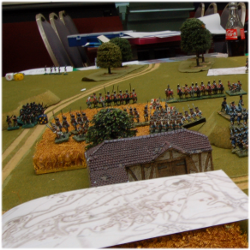 During
the first turn, the French troops arrive on table, a covering force in
semi-deployed formation, followed by a number of march columns.
Spotting fails miserably in the first turn, but the next turn it gets
interesting. During
the first turn, the French troops arrive on table, a covering force in
semi-deployed formation, followed by a number of march columns.
Spotting fails miserably in the first turn, but the next turn it gets
interesting.
On the left flank the advancing Saxons are spotted, and they manage to
spot von Pirch's brigade covering the central hill. Seeing the cavalry,
von Pirch orders his leftmost battalion in the corn field into square
formation.
Initial artillery exchanges manage to cause some light casualties on
the Saxon cavalry, who are soon overtaken by the infantry advancing
towards the yet unspotted von Jagow.
Von Jagow decides to reveal his artillery to open fire on the advancing
Saxons, causing some casualties.
|
Paris traffic
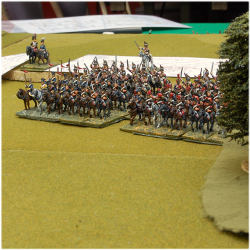 Before
they can advance again, the French cavalry is unveiled by the alert
eyes of von Ziethen himself. Expecting to be slightly outnumbered, the
overall amount of hostile cavalry still came as a shock - but
apparently not just to the Prussians. Still on a semi-deployed blinds,
the French cavalry is formed as one massive block of horse and men,
which will obviously take some sorting out before they can take an
active interest in anything other than traffic management. Before
they can advance again, the French cavalry is unveiled by the alert
eyes of von Ziethen himself. Expecting to be slightly outnumbered, the
overall amount of hostile cavalry still came as a shock - but
apparently not just to the Prussians. Still on a semi-deployed blinds,
the French cavalry is formed as one massive block of horse and men,
which will obviously take some sorting out before they can take an
active interest in anything other than traffic management.
Having confirmed the main hostile cavalry to be exactly where he
expected them to be, von Ziethen orders von Lutzow to move the light
cavalry to the right flank, in support of von Treskow's brigade.
Obviously von Treskow was going to need all the help he could get. |
More Paris traffic
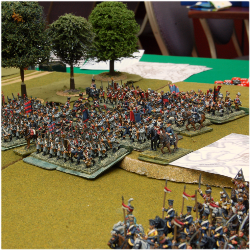 Von
Pirch's looking glass brought more to the eye than the cavalry - the
massed ranks of Legrand's division were now seen. Also still on a
semi-deployed blind, this massive division deployed well in depth
behind the blinds frontage. Apparently the cavalry was only a first
taste of close parking of troops, as this division alone already
outnumbered the Prussian infantry. The chaos caused by their premature
unveiling, combined with their attack orders forcing them forwards,
would mean that Oudinot spent more time helping organise his divisions,
than on keeping the larger picture and using his PIPs to give the right
orders to the relevant divisions. Von
Pirch's looking glass brought more to the eye than the cavalry - the
massed ranks of Legrand's division were now seen. Also still on a
semi-deployed blind, this massive division deployed well in depth
behind the blinds frontage. Apparently the cavalry was only a first
taste of close parking of troops, as this division alone already
outnumbered the Prussian infantry. The chaos caused by their premature
unveiling, combined with their attack orders forcing them forwards,
would mean that Oudinot spent more time helping organise his divisions,
than on keeping the larger picture and using his PIPs to give the right
orders to the relevant divisions.
Von Pirch, meanwhile, figured that his day would not be a happy one,
with these masses of troops deployed to his front. Especially since a
third of his troops consisted of the crack Westphalian landwehr who may
be good at downing lagers, but certainly did not have a reputation for
fighting spirit. Still, there seemed little to do other than to order
his extreme right flank battalions into square as well. |
Saxon advance on the left flank
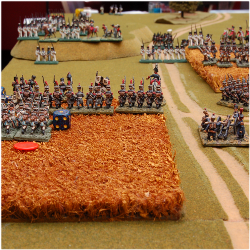 Some
atrocious dice rolling by the Prussian artillery meant they were not
hitting a thing. The Saxons were generous enough to demonstrate just
how artillery should be used - and with one salvo of ball caused
casualties in the Silesian schuetzen, the Berg grenadiers and the Berg
fusiliers behind them. Some
atrocious dice rolling by the Prussian artillery meant they were not
hitting a thing. The Saxons were generous enough to demonstrate just
how artillery should be used - and with one salvo of ball caused
casualties in the Silesian schuetzen, the Berg grenadiers and the Berg
fusiliers behind them.
Truly amazing dice rolling for the bombardment test meant that direct
intervention by von Jagow was required to prevent the schuetzen from
becoming shaken, and caused the Berg fusiliers to indeed reach a shaken
state.
Meanwhile the Saxon infantry had advanced to within pinning range of
the Prussian square, which as a result could not revert back to
something more appropriate like a column.
Von Jagow moved his musketeer battalion up on the right hand side, to
cover the guns in case von Pirch's square failed. |
Death ride of the Brandenburg dragoons
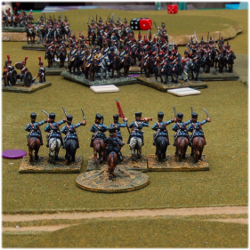 On
the right flank, von Treskow had been watching the deployment of the
French cavalry with some concern. Obviously the French had to be
contained in the narrow space between the woods and the squares on the
hill - allowing them any further meant they would easily be able to
overwhelm his few troops. To make things worse, von Lutzow's landwehr
cavalry was nowhere to be seen yet. At least von Ziethen seemed to
share his view, given the 'Attack' orders he had just received. On
the right flank, von Treskow had been watching the deployment of the
French cavalry with some concern. Obviously the French had to be
contained in the narrow space between the woods and the squares on the
hill - allowing them any further meant they would easily be able to
overwhelm his few troops. To make things worse, von Lutzow's landwehr
cavalry was nowhere to be seen yet. At least von Ziethen seemed to
share his view, given the 'Attack' orders he had just received.
With 2 regiments of French light cavalry (5th Hussars, 24th Chasseurs)
facing his Brandenburg dragoons, and the 23rd Chasseurs facing his
Silesian hussars, von Treskow ordered his cavalry to charge down the
hill. As far as casualties go, the results were nothing spectacular -
primarily due to abysmal die rolls by the Prussians. All sides were
thrown back, blown. But first of all his cavalry was still intact. And
what was better, forcing the French cavalry to fall back blown, caused
massive disorganisation for the French heavy cavalry. Over the
remainder of the turn, it took the full attention of the French cavalry
commander and CiC to get regain some semblance of order. |
Saxon infantry assault
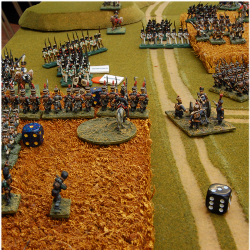 On
the left flank, meanwhile, the Saxon infantry assaulted the Prussian
lines. 2 battalions of the 1st brigade ran into firm resistance from
the Berg grenadiers, with both repulsed shaken. A volley of cannister
would soon see one of them routing, as well as the line that had formed
behind it. On
the left flank, meanwhile, the Saxon infantry assaulted the Prussian
lines. 2 battalions of the 1st brigade ran into firm resistance from
the Berg grenadiers, with both repulsed shaken. A volley of cannister
would soon see one of them routing, as well as the line that had formed
behind it.
In the other corn field, the odds were reversed. The Saxon line
battalion (D class) attacked the Berg infantry square, breaking them in
the process. The route of these troops would also sweep up the
battalion von Jagow had placed behind them to cover this eventuality -
unfortunately just too close. The arrival of 2 fresh battalions drawn
from von Pirchs center, however, stabilized the situation.
Watching von Jagow's success, von Ziethen issued a clear order - grasp
the initiative, attack and send the Saxons packing. |
Death ride of the Brandenburg dragoons, take 2
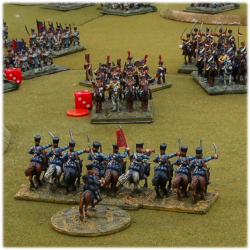 After
the French artillery caused significant casualties on their Prussian
artillery (2 hits, causing a 'shaken' result, which was rallied since),
Oudinot personally oversaw the advance of his cuirassiers, supported by
the lancers - giving the remainder of the cavalry some time and space
to regroup. On the Prussian side, the arrival of the Landwehr cavalry
provided some relief - but very shaky relief at best. After
the French artillery caused significant casualties on their Prussian
artillery (2 hits, causing a 'shaken' result, which was rallied since),
Oudinot personally oversaw the advance of his cuirassiers, supported by
the lancers - giving the remainder of the cavalry some time and space
to regroup. On the Prussian side, the arrival of the Landwehr cavalry
provided some relief - but very shaky relief at best.
Unfortunately for the French cuirassiers, their advance and that of
their infantry now blocked the field of fire of his artillery. At the
start of the next turn, von Ziethen's card came up. He ordered his
artillery to fire cannister into the cuirassiers at the bottom of the
hill, causing 2 casualties and shaking the French. Even though von
Ziethen could not order the charge of the dragoons, the next card up
was the Prussian bold commander.
Just what von Treskow needed to send his dragoons back into the fray.
They hit the French 7th cuirassiers, and never stopped going. Breaking
the cuirassiers, they sent them crashing through the 2 deployed
batteries behind them. Tasting blood, the Brandenburg dragoons kept
going, chasing off both of the battery gun crews, when their charge ran
out of steam, blown.
Unfortunately von Treskow had been unable to get his Silesian hussars
moving again (not enough PIPs), leaving the dragoons very exposed with
fresh French cuirassiers ogling the dragoons' flank for a charge. Von
Lutzows landwehr cavalry had now arrived on the right flank, but were
they close enough? |
Surely those dragoons will die now?
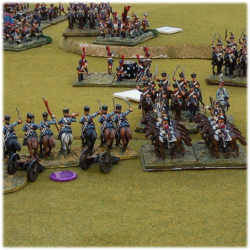 When
the French cavalry activation came up next, the dragoons fate
seemed sealed. The 8th lancers charged the landwehr cavalry facing
them, and the 14th cuirassiers charged the flank of the Brandenburg
dragoons. Two surprises came up next. First of all it was now the
French who scored abysmal die results, with the cuirassiers and
dragoons both falling back blown. In other words, the Brandenburg
dragoons survived, much to everyone's amazement. When
the French cavalry activation came up next, the dragoons fate
seemed sealed. The 8th lancers charged the landwehr cavalry facing
them, and the 14th cuirassiers charged the flank of the Brandenburg
dragoons. Two surprises came up next. First of all it was now the
French who scored abysmal die results, with the cuirassiers and
dragoons both falling back blown. In other words, the Brandenburg
dragoons survived, much to everyone's amazement.
The 8th lancers did manage to get a decisive result against the
landwehr cavalry, throwing them back behind the Silesian hussars.
Overall, this meant that the French cavalry division had been severely
blunted, and would no longer play a meaningful part in the remainder of
the battle, and a stand-off had been reached on the right flank.
On the left flank, the Berg grenadiers were ordered to attack the Saxon
infantry in front of them. Even though they severely outclassed them,
this attack fizzled in it's entirety and the left flank came to as
grinding a standstill as the right had. |
Running up that hill
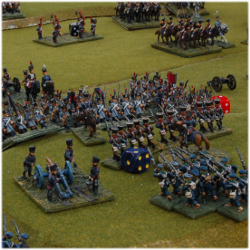 The
last area where a speedy breakthrough could be reached was the center.
Two French infantry brigades were advancing on von Pirch's brigade, but
short range cannister fire took the most of the sting out of that, in
fact sending two battalions routing by sheer fire volume. The
last area where a speedy breakthrough could be reached was the center.
Two French infantry brigades were advancing on von Pirch's brigade, but
short range cannister fire took the most of the sting out of that, in
fact sending two battalions routing by sheer fire volume.
Three battalions of the second brigade however did reach the West
Prussian musketeer line, flanked on each side by an artillery battery.
The odds here were close and slightly in favour of the French, but
apparently the Prussian line proved strong enough that the French could
not fight their way through. A firefight ensued, which was won by the
West Prussians. Luckily it never came down to the landwehr troops that
had been drawn up as supports, as they were very poor quality troops
indeed.
With the last imminent danger dealt with, night fell - giving the
Prussians time to bring up the remainder of the 1. Corps, and the
French to lick their wounds and figure out just what went wrong.
|
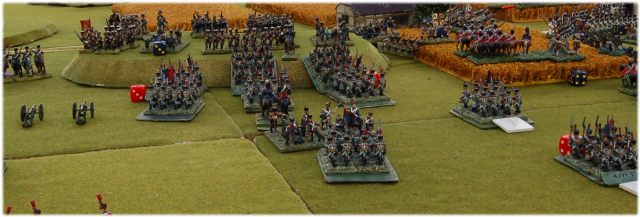 |
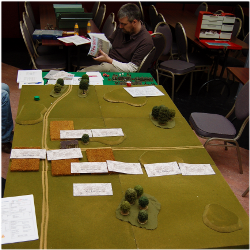 Objective:
Objective: Objective:
Hold the crossroads
until support from the remainder of 1. Corps arrives - no sooner than
nightfall.
Objective:
Hold the crossroads
until support from the remainder of 1. Corps arrives - no sooner than
nightfall.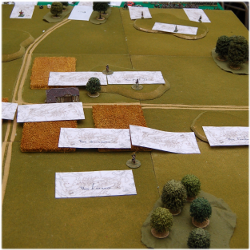 French
Orders and Deployment
French
Orders and Deployment